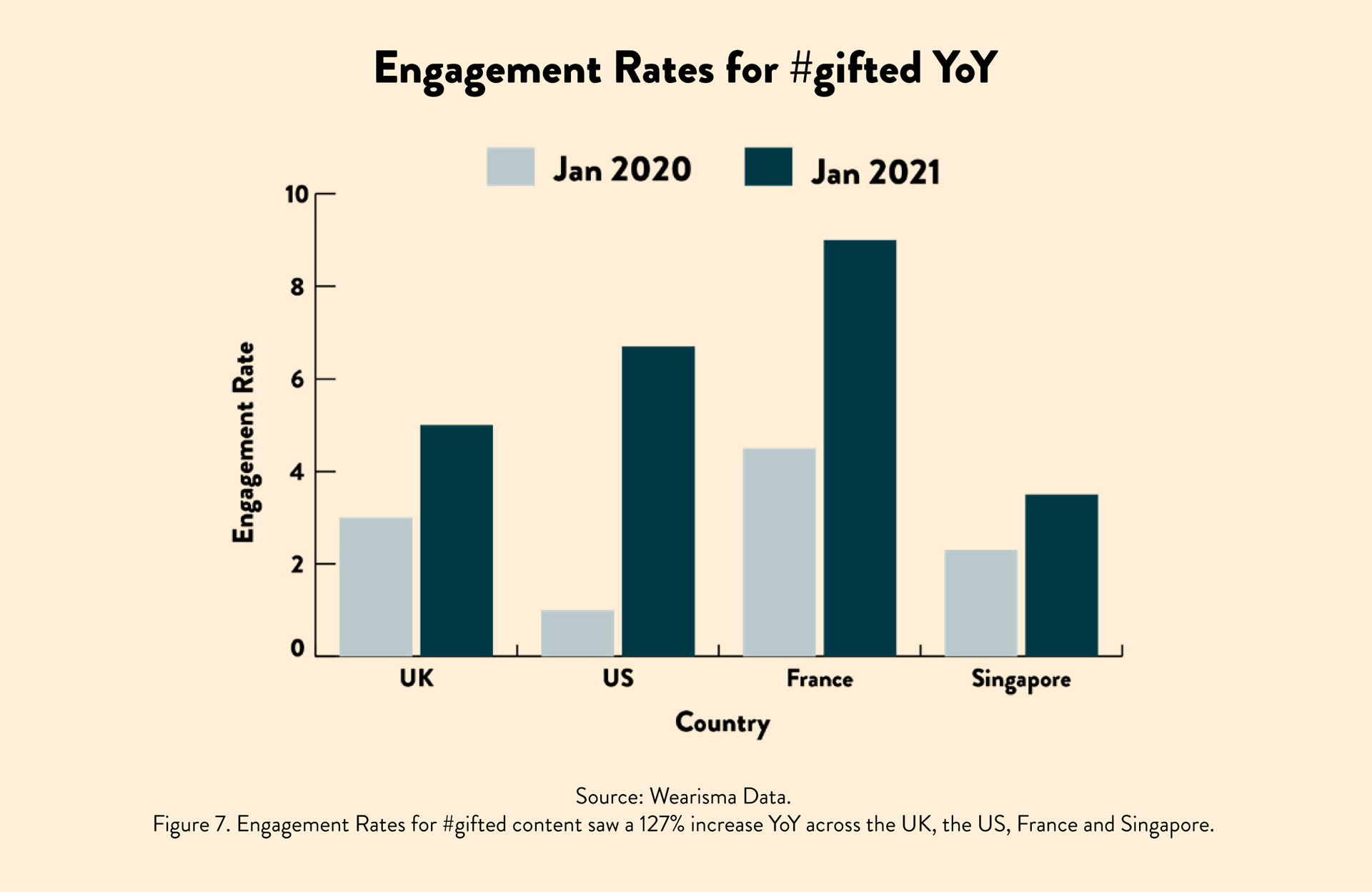Developments in social media, and the lasting impact of the global pandemic, have changed the face of marketing. Social media has provided important marketing tools for many years now, enabling influencers to build, and connect with, communities of followers.
But recent shifts have meant that consumers are moving away from engagement with the type of influencer who they don’t relate to, in favour of ‘real people’ who deliver trust, authenticity and transparency instead of flash; largely through:
- Social media sharing
- User-generated content (UGC)
- Customer referrals
- Online reviews
A recent white paper from Wearisma looks at how brand advocacy is changing, in a big shift towards building communities instead of audiences.
In this article I’ll share with you some of their most important findings and outline some of the key elements of an effective brand advocacy programme.
1. What is brand advocacy, and why does it work?
Brand advocacy is a way to build an authentic online community of people who genuinely love and support your brand. Yes, we still need influencers to generate high levels of engagement and curate professional content, but making the most of our social media content now involves a shift towards content generated by customers themselves.
It’s not unlike traditional ‘word of mouth’ marketing, but now we can make use of modern digital channels to locate our genuine ambassadors within our customer base.
Wearisma have a simple way to explain the differences between influencers and advocates.
Source: Wearisma
So brand advocates can be either influencers or consumer advocates. From a community point of view, the magic happens when the enthusiasm of a consumer of your brand creates a desire to talk about you online through positive reviews, mentions and recommendations. Combine this with influencers who have a genuine passion for your brand rather than an eye solely on the metrics, and you have a potentially powerful community of brand advocates.
In Wearisma’s study, they found that 74% of people stated that more recommendations from people they know would encourage them to purchase from brands.
2. Trust, transparency and purpose – the three pillars of brand advocacy
The brand/consumer relationship has undergone a major shift recently, and the power is very much in the hands of consumers. Consumers are, increasingly, insisting on a genuine sense of connection with brands, a connection for which trust is essential.
That’s why community has become a vital online experience. Consumers trust their communities – whether physical or online – more than advertising, so messages ‘pushed out’ by a brand are no longer sufficient or acceptable for building trust.
With consumers easily able to block messages they don’t want to receive, building authentic online communities and engaging consumers personally is essential. According to Wearisma, brand advocacy is the leading strategy for achieving this level of engagement.
Building trust relies on authenticity and transparency. Consumers need to be assured that the content they are seeing is genuine, and originating from people with a ‘passionate, emotional attachment with a brand’.
So who are these people?
Wearisma’s research included looking at the essential attributes of successful brand advocates. It revealed a demand for advocates who are passionate about the brand and will provide honest reviews – including negative ones. They need to be genuine, knowledgeable users of the products, and to be transparent about their other interests and partnerships.
Source: Wearisma
This transparency is particularly important when your consumers consist mainly of Gen Z and Millennials, as they tend not to be simply purchasers of a product. For these consumers, the brands they buy from reflect and are aligned with their personal core beliefs and values. So the personality and purpose of the brand is as important as the product – if not more so.
Brands who can have real conversations with the consumers, rather than always talking like a brand, tend to develop better relationships, and their consumers are more likely to move to becoming brand advocates.
Wearisma gives Ann Summers as an example of how building trust and connections with real people online has turned consumers into passionate advocates who go on to feature in brand campaigns.
3. Some dos and don’ts of a brand advocacy programme
An affect brand advocacy campaign will enable you to leverage the power of your biggest fans, helping you to:
- build the genuine brand love which is fast emerging as the most effective form of advertising
- remain relevant to your online community
- cut costs whilst driving impact
But some brands have made a few mis-steps, having failed to understand how vital a role authenticity plays.
Don’t rely on mass campaigns
Wearisma gives an example of brands who, in an attempt to build their online communities, have sent out mass DM campaigns, offering consumers discounts in exchange for their content. Whilst, on the face of it, this might seem like a perfectly reasonable idea, to today’s consumer it lacks authenticity, and may even look suspect – like a scam. This tactic lacks the personal touch which is at the centre of authentic brand advocacy. An offer in exchange for the label of ‘ambassador’, coming from a brand with which a consumer may have minimal or no prior relationship, is meaningless and may even deter people from engaging with you further.
Do nurture relationships with individuals
An effective brand advocacy strategy involves identifying the consumers who already love your brand but don’t (yet) consider themselves advocates. Whilst their reach might be smaller than a popular influencer, their impact within their own networks is likely to be greater. Plus, the chances are that their network consists of people like them – who share at least some of their values and core beliefs. So if they already love your brand, their community is already partly self-selected to love it too.
Do give something back
One of the ways to engage with your consumers and nurture them to become brand advocates is through gifting.
If these consumers are already posting positive content about you online, give them something back, as a thank-you for their support, and encourage them to share more about their relationship with your brand.
A well-thought out gifting strategy as part of your loyalty programmes, will enable you to reward the ambassadors for their authentic promotion of your brand. Wearisma’s research has shown that audiences are becoming more interested in content that highlights how brands are thanking their advocates for their loyalty, and also that 76% of people say they would be encouraged to purchase if first given a gift.
Source: Wearisma
Tiered gifting allows you to reward your advocates according to how much engagement their content generates – rewarding your highest performing fans more generously will help to further build the relationship and connections.
One way to approach tiered gifting.
- Step 1: Design your tiers. You can have as many gifting tiers as you like, but a simple place to start might be a discount code (level 1), a sample product (level 2), and a full-size product (level 3). If you’re just starting out, begin with every advocate at level 1.
- Step 2: Track your advocates. Once you’ve sent out rewards, you need to keep an eye on what your advocates are doing. Are they responding by posting further positive content about your brand?
- Step 3: Monitor activity. Which advocates are creating the best performing content? You can track this with metrics like Engagements, Engagement Rate and Media Value, as well as tracking which content is driving traffic to your website and creating sales.
- Step 4: Tier placement. Once you can see who are the top performers for your brand, you can reward them further, by moving them up a tier, then repeat steps 2 and 3. Keep rewarding everyone else at level 1 to maintain loyalty and engagement!
Summary: Why you should be considering a brand advocate strategy for your brand
Your best brand advocates will be highly active online, will have a great social reach, and will represent your company in the best way possible. They are likely to be customers, but could also be employees or partners.
The benefits for your brand will be:
- using the power of your advocates to reach more potential consumers, both online and in-person
- it’s a more authentic form of marketing, as your advocates are people who believe in your brand, andsupport it without being paid to do so
- in an online world, it humanises your brand, and potential customers see it as more genuine, creating empathy, personality, and trust
- it can create media interest – when publications see people talking about your brand, you are more likely to get your products featured
- it’s a great way to educate people about your products or services
- although you may need to invest a bit of money and effort in building your strategy, having a strong community of brand advocates can ultimately reduce the time and money you need to invest in marketing
You can download and read the full Wearisma report here.
If you’d like to explore how to build an effective brand advocacy programme, let’s talk.
Gordon Glenister is the author of a new book, Influencer Marketing Strategy. Learn:
- how to build an influencer strategy
- what makes a great influencer
- about the rise of Clubhouse and TikTok
- about future digital trends for connecting with a digital customer
Order your copy from Kogan or Amazon
Find out more at: http://gordonglenister.com/





